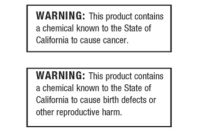Category: Chemicals
Today’s workplace uses thousands of chemicals, many of which are hazardous. The resources in this section will help guide you in the safe and legal identification, storage, transport, and use of these chemicals, and in making sure that your employees right to know how to be safe around such substances is provided, as required by law.
Complete Question: I am developing an updated hazardous material inventory for my Hazard Communication (HazCom) program. We are a industrial supply/hardware supply company that maintains an inventory of paints, thinners, lubricants, and cleaners etc. The employees do not use these substances, but do handle them from receiving, to the shelf, to the customer. What should be […]
After the EPA extended the public comment period on its problem formulation documents for the first 10 chemicals that will receive risk evaluations under the amended Toxic Substances Control Act (TSCA), major stakeholders provided radically divergent views of both the documents and the EPA’s approach to developing them.
See how Safety.BLR.com® experts answered the following question: “We have a general industry Texas customer whose business insurance company is requiring that they store all their flammable aerosols in flammable lockers, even if there is less than 25 gallons. Is this true?”
The EPA recently found a company in violation of the Emergency Planning and Community Right-to-Know Act’s (EPCRA) hazardous chemical inventory (also known as Tier II) and Toxics Release Inventory (TRI) reporting requirements and levied a penalty of over $160,000. Are you confident in your compliance with EPCRA reporting requirements? Now might be a good time […]
The EPA is taking steps to address the presence of per- and polyfluoroalkyl substances (PFAS) in drinking water and other media, but, to date, the Agency’s actions involve gathering more information rather than issuing regulations. In its latest announcement, the EPA discusses its use of nontargeted analysis to identify PFAS in samples. This method allows […]
In a letter of interpretation dated August 3, 2018, U.S. OSHA’s Directorate of Enforcement Programs provided several valuable insights into the extent chemical manufacturers, distributors, or importers may make use of trade secret protections when completing safety data sheets (SDSs), formerly material safety data sheets (MSDSs).
Dangerous chemicals necessitate adequate security to mitigate risks. If you are a facility with a chemical designated by the U.S. Department of Homeland Security (DHS) as a chemical of interest (COI), you may only have 60 days after taking possession of the COI to initiate a security screening process under the Chemical Facility Anti-Terrorism Standards […]
On August 30, 2018, California’s complex new Proposition 65 requirements for “clear and reasonable warnings” will take full effect, impacting companies across the country that do business in the Golden State. Though the Office of Environmental Health Hazard Assessment (OEHHA) adopted the new regulations in August 2016, businesses have had a 2-year phase-in period to […]
The tragic explosion of fertilizer-grade ammonium nitrate at the West, Texas, distribution facility in April 2013 has had a powerful impact on the direction of the EPA’s implementation of the Clean Air Act’s Risk Management Program (RMP, CAA Section 112(r)).
After years of sputtering progress, the Department of Homeland Security’s (DHS) Chemical Facility Anti-Terrorism Standards (CFATS) program is beginning to resemble a well-run, if not yet mature, government-industry undertaking.








